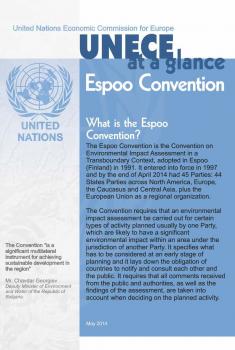
 Available in English, and in Russian.
Available in English, and in Russian.The Espoo (EIA) Convention sets out the obligations of Parties to assess the environmental impact of certain activities at an early stage of planning. It also lays down the general obligation of States to notify and consult each other on all major projects under consideration that are likely to have a significant adverse environmental impact across boundaries (see some examples).
The Convention was adopted in 1991 and entered into force on 10 September 1997 (see which countries are Parties to the Convention). Read more about the history of the Convention »
The sixth session of the Meeting of the Parties to the Convention took place in Geneva in June 2014.
First amendment to the Convention was adopted in 2001. Once in force (see status), it will open the Convention to accession upon approval by UN Member States that are not members of the UNECE
Second amendment to the Convention was adopted in 2004. Once in force (see status), it will
- Allow, as appropriate, affected Parties to participate in scoping
- Require reviews of compliance
- Revise the Appendix I (list of activities)
- Make other minor changes
The Espoo Convention and the Rio Declaration on Environment and Development (1992)
- Principle 17: Environmental impact assessment, as a national instrument, shall be undertaken for proposed activities that are likely to have a significant adverse impact on the environment and are subject to a decision of a competent national authority.
- Principle 19: States shall provide prior and timely notification and relevant information to potentially affected States on activities that may have a significant adverse transboundary environmental effect and shall consult with those States at an early stage and in good faith.

